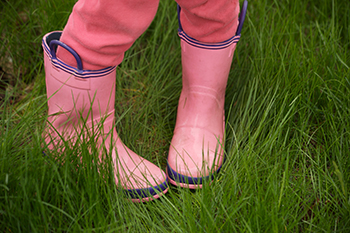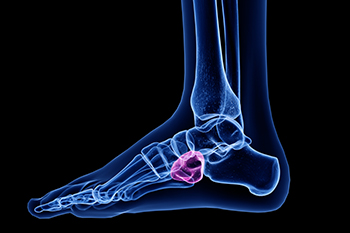Items filtered by date: January 2025
Causes and Affected Age Groups of Pigeon Toed Children

Pigeon toe, also known as in-toeing, is a condition where a child’s feet turn inward while walking or running. This misalignment often appears when children begin to walk and is commonly seen at younger ages. The primary causes of pigeon toe include metatarsus adductus, where the front part of the foot curves inward, tibial torsion, which is a twist in the shin bone, and femoral anteversion, a condition where the thigh bone turns inward. These conditions can affect children during different stages of growth, particularly between the ages of one and four, as they develop their walking and coordination skills. In many cases, pigeon toe resolves on its own as children grow and their bones and muscles strengthen. If your child has this condition, it is strongly suggested that you are under the care of a chiropodist who can effectively monitor their foot health.
If your child is experiencing foot or ankle pain, please consult with Emily Yu, B.Sc from Uptown Foot Care Clinic. Our specialist will assess your condition and provide you with quality foot and ankle treatment.
Common Causes of Foot Pain in Children
While children can experience many of the same foot problems as adults do, some foot problems may be more common during childhood.
Causes of foot pain in children can include:
Deformities that are present from birth, such as flat feet or clubfoot
Sever’s disease, which is an inflammation of the growth plate in the heel bone
Various sports injuries, such as sprains and fractures
Ingrown toenails
Athlete’s foot
Plantar warts
Prevention
It is important to look after the health of children’s feet in order to prevent future problems from arising. Keep your child’s feet clean and dry, trim their toenails regularly, ensure their shoes fit properly, and keep a watchful eye on any symptoms of foot pain, such as limping. If you notice any symptoms or if your child complains of foot pain, a chiropodist can help.
If you have any questions, please feel free to contact our office located in . We offer the newest diagnostic and treatment technologies for all your foot care needs.
Causes and Symptoms of Ingrown Toenails

Ingrown toenails are a common condition that often affects teenagers, young adults, and people who are overweight. Ingrown toenails typically occur on the big toe but can also affect other toes. Common causes include cutting nails incorrectly and wearing tight or poorly fitted shoes. Fungal infections, injuries, sweaty feet, and genetic factors such as naturally curved nails are other factors. Symptoms include redness, swelling, and pain along the edges of the toenail, which may worsen with pressure from shoes. Infections can develop if the condition is not treated, leading to increased discomfort and visible pus or discharge. Prevention focuses on proper nail trimming techniques, such as cutting nails straight across, and wearing comfortable, well-fitted shoes and socks. If you need help managing an ingrown toenail, it is suggested that you schedule an appointment with a chiropodist.
Ingrown toenails may require medical attention. If you have significant pain or notice signs of infection from an ingrown toenail, please consult with Emily Yu, B.Sc from Uptown Foot Care Clinic. Our specialist will assess your condition and provide you with quality foot and ankle treatment.
What Is an Ingrown Toenail?
An ingrown toenail occurs when the edges of a toenail grow into the surrounding skin. The toenails of the big toe are usually affected, however, an ingrown toenail can happen on any toe. Sometimes, the area can become infected leading to potentially serious complications. The ingrown toenail may be caused by improper trimming of the toenail, wearing ill-fitting shoes, or injury to the nail.
Symptoms
The symptoms of an ingrown toenail include:
Pain
Swelling
Redness
Warmth
Pus or drainage from the affected nail or a fever may indicate an infection of the area.
Treatment
Treatment depends on the severity of the ingrown toenail. In less severe cases, home treatment may be adequate. Soaking the affected foot in warm water and gently lifting the nail from the skin with a piece of clean cotton can help. In more severe cases, you may need to use topical or oral antibiotics to treat an infection. Surgical removal of the ingrown toenail may be required if more conservative treatments fail.
Ingrown toenails may be prevented by wearing well-fitted shoes and properly trimming the toenails. Toenails should be trimmed straight across and not too short when using nail clippers.
If you have any questions, please feel free to contact our office located in . We offer the newest diagnostic and treatment technologies for all your foot care needs.
Overdoing It on the Pickleball Court

While pickleball is less rigorous and more accessible than tennis, injuries are still surprisingly common, often stemming from chronic overuse or playing too intensely. Among the most frequent injuries are ankle sprains, which occur when the ligaments supporting the ankle are stretched or torn. Quick lateral movements, sudden stops, or missteps can lead to the ankle rolling inward, causing pain, swelling, and instability. Overdoing it, such as playing multiple matches without rest, can exacerbate the risk, especially for players who do not take time to recover. Proper preparation, like wearing court-specific shoes and strengthening ankle stability through targeted exercises, helps reduce the likelihood of sprains. If you play pickleball and experience persistent pain, swelling, or difficulty bearing weight, it is suggested that you consult a chiropodist for expert care.
Ankle pain is a common symptom of many lower limb problems. If you are experiencing ankle pain, please consult with Emily Yu, B.Sc from Uptown Foot Care Clinic. Our specialist will assess your condition and provide you with quality foot and ankle treatment.
The ankle is composed of a number of muscles, bones, tendons, and ligaments. There are many conditions which may cause ankle pain.
Causes
Ankle strains or sprains
Achilles tendon injuries
Fractures
Bursitis
Arthritis
Gout
Tarsal tunnel syndrome
Symptoms
If you have ankle pain, you may also experience a variety of other symptoms depending on the underlying cause of the pain. Some of these symptoms may include ankle swelling, bruising, redness, numbness or tingling, instability, and difficulty walking.
Diagnosis
The underlying cause of ankle pain can be diagnosed by a chiropodist. Diagnoses are typically made based on your medical history, a physical examination of the affected ankle, and imaging studies such as X-rays.
Treatment
Treatment for your ankle pain will depend on its underlying cause. Often, the chiropodist will recommend that you rest the affected ankle. You might also need to ice, compress, and elevate the ankle, wear an orthotic device, or take medications to reduce pain and inflammation.
If you have any questions, please feel free to contact our office located in . We offer the newest diagnostic and treatment technologies for all your foot care needs.
Cuboid Syndrome Facts

Cuboid syndrome affects the cuboid bone located on the foot's outer side. It occurs when the cuboid bone becomes slightly dislocated or out of alignment. The main causes of cuboid syndrome include sudden twisting movements, overuse, or injuries like ankle sprains that put stress on the foot. Symptoms typically include pain on the outer part of the foot, difficulty walking or standing for long periods, and swelling or tenderness surrounding the affected area. In some cases, individuals may feel a sensation of instability in the foot. Diagnosing cuboid syndrome usually involves a physical examination where a chiropodist will check for tenderness and misalignment. Imaging tests like X-rays may rule out fractures, but in many cases, the diagnosis is made based on symptoms and the history of injury. If you have pain on the outside of your foot, it is suggested that you consult a chiropodist who can offer you effective treatment solutions.
Cuboid syndrome, also known as cuboid subluxation, occurs when the joint and ligaments surrounding the cuboid bone in the foot become injured. If you think that you may have cuboid syndrome, please consult with Emily Yu, B.Sc from Uptown Foot Care Clinic. Our specialist will assess your condition and provide you with quality foot and ankle treatment.
Causes
The cuboid bone is one of the seven tarsal bones located in the foot. Cuboid syndrome develops when the cuboid bone moves down and out of alignment with the other bone (calcaneus bone) in the joint of the foot. Cuboid syndrome can be the result of a sudden injury like an ankle sprain, or it may develop slowly over time from repetitive tension through the bone and surrounding structures.
Symptoms
The most common symptom of cuboid syndrome is pain on the outside of the foot which may worsen with activity.
Other possible symptoms include:
Difficulty bearing weight on the affected foot
Swelling
Sensitivity on the bottom of the foot
Reduced range of motion
Diagnosis
A chiropodist can diagnose cuboid syndrome based on your medical history and a physical examination of the foot. Imaging studies, such as X-rays or MRIs, often fail to show the dislocated cuboid.
Treatment
Treatment often includes resting, icing, compressing and elevating the affected foot, taping, wearing orthotic inserts, and taking anti-inflammatory medications to reduce pain. The chiropodist may also be able to manipulate the dislocated bone back into alignment.
If you have any questions, please feel free to contact our office located in . We offer the newest diagnostic and treatment technologies for all your foot care needs.

